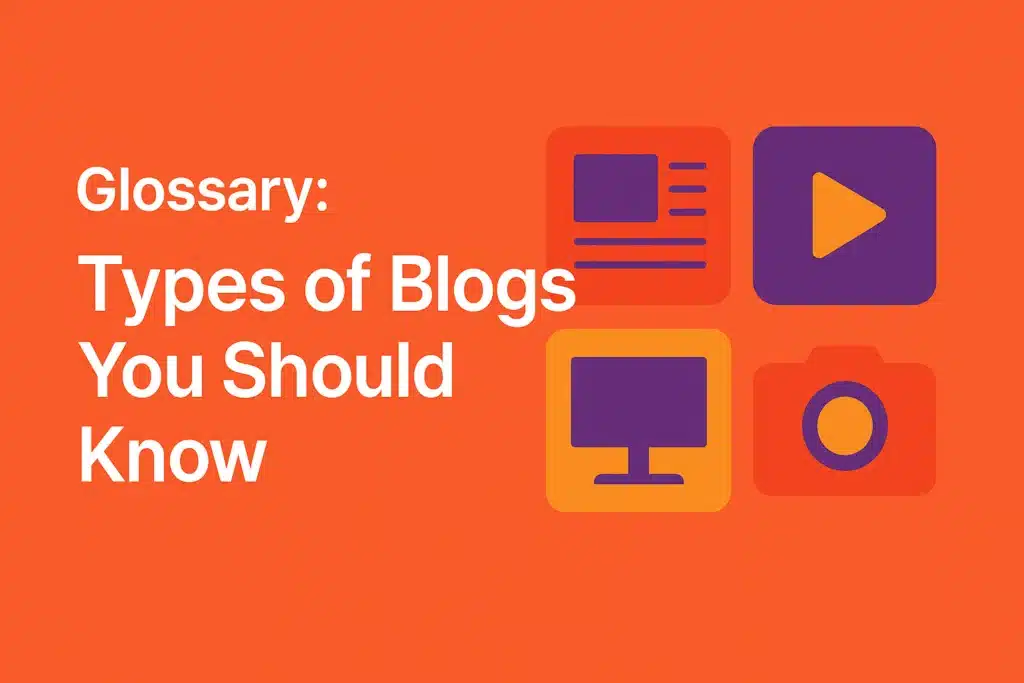Blogs shape online discussions for people and teams worldwide. Over 600 million blogs exist among 1.9 billion websites, which shows blogging is for sharing knowledge and building groups (Big Star Copywriting). Readers are attracted to personal stories, business insights, and niche topics, making this digital medium a major spot for personal expression and brand growth.
What Are the Main Types of Blogs?
Blogs vary in many kinds. Personal posts help people connect through stories. Business-based writing often drives brand reach steadily without major ads (Link-Assistant). Niche topics interest readers who want deeper insights. Hobby platforms gather interests. News and political sites highlight current events. Teaching pages guide learners. Each style supports distinct aims.
1. Personal blogs: Sharing thoughts and stories
Personal blogs focus on a person’s life, views, or daily actions. They create lasting connections by sharing genuine stories. People often come back for frank accounts and tips. This layout is a reliable outlet for personal expression, giving each writer a direct way to reach readers each day.
2. Business blogs: Driving brand exposure
Business blogs improve online visibility with content about products, services, and trends. They attract search traffic, helping firms gain leads minus large ads (Link-Assistant). Steady posts also improve reputation and brand image among possible clients, as daily readers value tips and direct insights from these brands.
3. Niche blogs: Focused insights on specific topics
Niche blogs focus on specific fields like finance, sports, or travel. Writers share deep knowledge to build trust with fans. A narrower theme creates continued interest, especially if the blogger loves the subject. This passion keeps content flowing even when visits are low at first.
4. Hobby blogs: Exploring interests and skills
Hobby blogs often focus on pastimes or hands-on crafts like cooking or painting. They attract readers who want fresh ideas. Writers share techniques, wins, and attempts, inviting readers to learn together. These blogs may become profitable ventures if the niche appeals to sponsors or affiliate networks.
5. News and political blogs: Presenting current events
News and political blogs highlight fresh stories, policy shifts, and big changes. They attract readers seeking fast takes and frequent updates. Bloggers post often to stay relevant, which can grow readership. Accuracy and balanced comments matter here because people want reliable information on current events.
6. Teaching blogs: Teaching or explaining subjects
Teaching blogs guide readers on broad and focused topics. Authors include teachers, pros, or fans who simplify difficult ideas. Their posts help visitors understand material at their pace. By offering clear lessons or answering recurring queries, these blogs improve comprehension and motivate deeper learning.
How Do Types of Blog Content Differ?
Blog content differs based on purpose and style. Informative posts spread knowledge, while opinion-based entries share specific viewpoints. How-to tutorials explain steps, and list-style pieces organize ideas neatly. Interviews present fresh perspectives, and curated posts compile resources in one place. Each approach fulfills different reader needs and unique search needs.
1. Informative content: Teaching and spreading knowledge
Informative posts provide specific information or background details on a topic. They often include meanings, examples, and data to help readers learn quickly. This structure appeals to readers researching new subjects. Writers address common questions, enhancing credibility and building trust through trusted references or cited research findings.
2. Opinion-based content: Proposing viewpoints or analysis
Opinion-based content presents personal viewpoints or critiques about events, products, or ideas. Writers express standpoints to start conversations and engage readers. While evidence helps maintain trust, subjective thoughts also attract readers eager for unique angles. This style often appeals to those seeking fresh analysis or debate.
3. How-to content: Step-by-step instructions
How-to articles divide tasks into manageable steps that address challenges effectively. Authors explain each step with visuals when necessary, allowing readers to follow along easily. This format shows expertise in practical areas, earning praise and return visits. Clear instructions encourage people to complete projects without confusion.
4. List-style content: Organized by numbers or bullets
List content organizes information into concise numbered or bulleted sections. This approach makes scanning simpler, encouraging quick sharing and discussion. People find it helpful for identifying key tips or suggestions. Whether rating top items or highlighting vital practices, lists convert detailed information into an easier read.
5. Interview formats: Featuring other people
Interview posts present other perspectives or experiences in a Q&A style. Bloggers compile questions and arrange them logically, offering variety and generating new insights. Readers enjoy this behind-the-scenes access, which can be both inspiring and helpful. Featuring guest voices also increases the site’s credibility.
6. Curated content: Collecting resources in one post
Curated content collects multiple sources or tools into a single piece. Bloggers sift through relevant material, then present the best links, articles, or software. By offering a one-stop resource, they save readers time when finding answers. This approach improves a blog by highlighting useful external sources.
What Are Common Professional Blog Formats?
Professional blog formats create reliable content for businesses or specialized readers. Tutorial blogs show how to accomplish tasks step by step. Review content evaluates products or services. Case study posts present real results, showing measurable results. Comparison pieces contrast different options. Resource guides compile vital details. These formats match a brand’s focus, improving its authority and meeting Google’s demand for trustworthy content (Link-Assistant).
1. Tutorial blogs: Guiding readers through tasks
Tutorial blogs explain steps in a clear order. Readers follow each stage to master new software or complete projects. Authors often include visuals or videos, eliminating confusion and building confidence. This format shows practical knowledge that appeals to readers eager to learn.
2. Review blogs: Giving detailed product opinions
Review blogs assess offerings based on direct experience, pointing out advantages and drawbacks. They help customers make informed decisions. Honest insights lead to higher trust in the reviewer. Sponsored partnerships may appear, but candor remains essential for maintaining credibility with readers.
3. Case study blogs: Describing real-world results
Case study blogs detail real events, such as achievements or industry findings. Writers explain methods and report specific results for clarity. Showing concrete results builds credibility, as it validates expertise and responsibility. These posts encourage readers to use successful methods in their own work.
4. Comparison blogs: Analyzing two or more options
Comparison blogs evaluate different options together. Writers examine benefits and limitations to clarify which option might suit specific needs. This perspective reduces uncertainty and supports informed decisions. Readers refer to these comparisons before making important choices.
5. Resource guide blogs: Building ultimate reference guides
Resource guide blogs gather useful tools, articles, or structured tutorials into a single overview. Writers detail trusted materials that fix problems or broaden skills. This method establishes a blog’s reputation as a trusted asset. People frequently reference these posts for convenient help with a topic.
Conclusion
Blogs remain crucial for sharing information, building trust, and building communities. Whether a writer focuses on personal storytelling, brand awareness, or in-depth topics, each format reaches audiences searching for relevant details. By selecting content types that fit a writer’s goals, it becomes easier to stay consistent and gain loyal followers. Personal reflections spark curiosity, while business or professional angles demonstrate credibility. Some creators prefer how-to posts that simplify topics, and others might thrive with curated or interview strategies. The options are endless, yet quality remains crucial. Thoughtful writing, trusted sources, and an authentic tone build reader trust and promote regular visits. This approach maintains progress and encourages long-term success in a competitive online environment.
FAQs
These questions address common questions about blog groups, SEO, expert status, revenue, and brand fit. Readers often wonder which style suits their needs when starting or improving a site. The following answers explain important aspects for clearer direction and better blogging results.
What are the most popular types of blogs today?
How do different types of blog content affect SEO performance?
Which professional blog formats are ideal for gaining expert status?
Can one blog include multiple types of blog content?
What type of blog is best for making money online?
How do I choose between various types of blogs for my brand?

Ridam Khare is an SEO strategist with 7+ years of experience specializing in AI-driven content creation. He helps businesses scale high-quality blogs that rank, engage, and convert.



